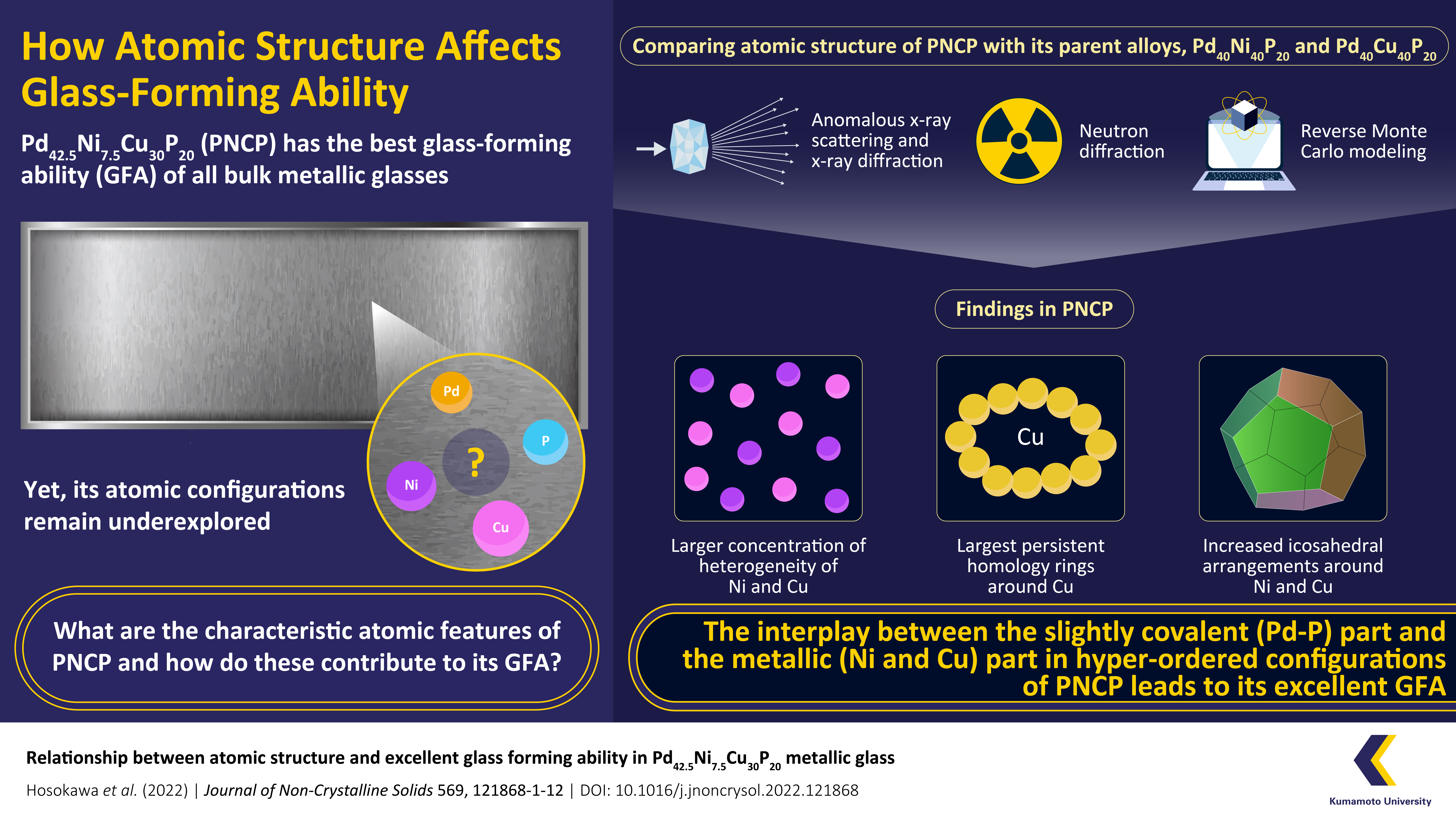Mystery of this Champion Metallic Glass Uncovered

Researchers explain how a unique underlying atomic structure gives Pd42.5Ni7.5Cu30P20 its excellent glass-forming ability
Pd42.5Ni7.5Cu30P20 (PNCP) is considered the champion of bulk metallic glasses with regards to its glass-forming ability (GFA), yet the atomic configurations that lead to this property remain unknown. Recently an international team of researchers led by Prof. Shinya Hosokawa of the Kumamoto University, Japan analyzed the atomic configurations of PNCP, compared it with previous alloys, and found its characteristic configurations and the origin of its GFA. This can help us create better metallic glasses.
Metallic glass is a revolutionary material which combines the flexibility of glass with the strength of metals. These are made by rapidly cooling a liquid metal or alloy such that the atoms freeze in a random pattern, much like liquids, rather than the regular pattern of normal metals. This random liquid-like pattern is also seen in glass, lending the material its name. Pd42.5Ni7.5Cu30P20 (PNCP) is considered the champion of metallic glasses due to its excellent glass-forming ability (GFA). This alloy is much better than either of its parent alloys, Pd40Ni40P20 (PNP), which shows a slightly worse GFA and Pd40Cu40P20 (PCP), which shows a much worse GFA than PNCP. Yet the atomic configurations characteristic to PNCP, which make it an excellent metallic glass, remained a mystery.
In a recent paper which was made available online on 25 August 2022 and published in Volume 596 of the Journal of Non-Crystalline Solids on 15 November 2022, a team of researchers from Japan, Germany, France, Hungary, and the UK brought us one step closer to solving this mystery. Led by Professor Shinya Hosokawa of the Kumamoto University, Japan, they successfully analyzed the atomic structure of PNCP and compared it with the atomic structure of PNP and PCP to find the characteristic configurations that may lead to the excellent GFA of PNCP. “While previous studies have tried to formulate rules that can predict the GFA of metallic glasses, these have not been experimentally verified. Our findings show that these rules might not be true. Moreover, our research shines a light on the next steps that must be taken to understand how the atomic configurations of other metallic glasses affect their GFA,” said Prof. Hosokawa.
Through multiple observation techniques like anomalous X-ray scattering, X-ray diffraction, and neutron diffraction, the atomic configurations of a PNCP sample of 3 mm diameter were elucidated. These were analyzed using techniques like reverse Monte Carlo modelling. The observations were then compared with similar ones from PNP and PCP.
The team found distinct differences in the atomic configurations of PNCP compared to its parent alloys. For starters, PNCP displayed more heterogeneity in its secondary metals, nickel and copper, compared to the secondary metals in PNP (i.e., nickel) and PCP (i.e., copper). Nickel and copper were not uniformly distributed in PNCP. Moreover, the team observed increased icosahedral arrangements around nickel and copper in PNCP. Lastly, findings from persistent homology (PH), a method for computing the topology of compounds, showed that PNCP contained the largest copper PH rings of any palladium-based bulk metallic glasses.
Drawing from these findings, the researchers concluded that in PNCP, the slightly covalent part (made by palladium and phosphorus, or Pd-P) and the metallic part (made by nickel and copper) are interplayed with each other, and this leads to PNCP’s excellent GFA. Prof. Hosokawa explains why these findings are useful: “Our results can help others understand the origins of excellent glass-forming ability in many metallic glasses, not just PNCP. Further research can build upon ours and help develop better metallic glasses in the future.”
Metallic glasses have good flexibility, strength, and resistance to corrosion. Thus, there is massive potential in the use of these materials. Advances like this can make the use of metallic glasses more common in our world and can bring us one step closer to realizing the potential of these unique materials.
About Professor Shinya Hosokawa
Dr. Shinya Hosokawa is a Professor at the Institute of Nanomaterials, Kumamoto University of Japan. He received his master’s degree and PhD from Kyoto University in Japan. He is also affiliated with the Department of Chemistry at Philips University of Marburg, Germany. His research areas include non-crystalline solids, semiconductor-metal transition, X-ray fluorescence holography, and synchrotron radiation among others. He has published over 300 papers.
[Funding]
- Japan Society for the Promotion of Science (JSPS): Grant-in-Aid for Transformative Research Areas (A) ‘Hyper-Ordered Structures Science’ (Nos. 20H05878 and 21H05569),
- Japan Society for the Promotion of Science (JSPS): Grant-in-Aid for Scientific Research (C) (No. 22K12662),
- Japan Science and Technology Agency (JST) CREST (No. JPMJCR1861),
- Deutsche Forschungsgemeinschaft (DFG) Mercator Fellowship in FOR 2824.
- Royal Society–EPSRC Dorothy Hodgkin Research Fellowship

